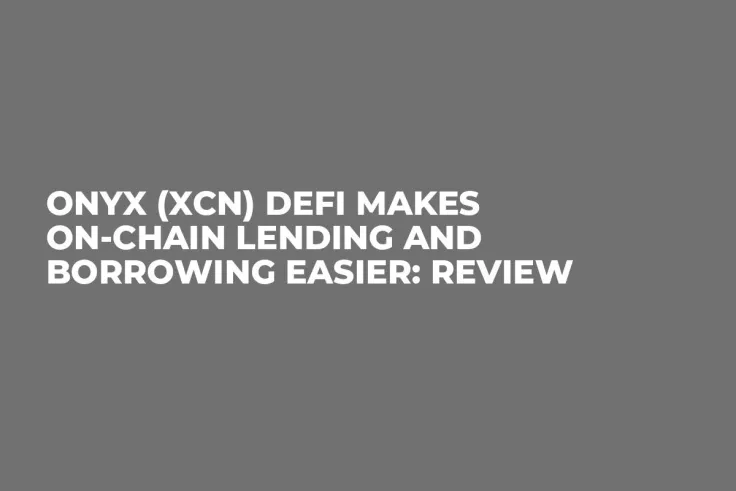
Disclaimer: The opinions expressed by our writers are their own and do not represent the views of U.Today. The financial and market information provided on U.Today is intended for informational purposes only. U.Today is not liable for any financial losses incurred while trading cryptocurrencies. Conduct your own research by contacting financial experts before making any investment decisions. We believe that all content is accurate as of the date of publication, but certain offers mentioned may no longer be available.
As the segment of altcoins is recovering from the aftermath of the 2022 Crypto Winter and recent regulators' attacks, more and more cryptocurrency enthusiasts are seeking opportunities to benefit from DeFi protocols.
Image by Onyx
Noncustodial lending/borrowing mechanisms are popular and newbie-friendly protocols designed to allow cryptocurrency holders to generate yield on their assets. Onyx (XCN) addresses the challenges of this segment in a completely new manner.
Onyx (XCN) DeFi offers noncustodial crypto lending for newbies and pros: Highlights
Launched in March 2023, Onyx (XCN) DeFi protocol allows cryptocurrency holders to earn yield from lending and borrowing operations on its noncustodial platform:
- Onyx Protocol, or Onyx, is a 100% on-chain lending and borrowing protocol for the cryptocurrencies of Ethereum (ETH) blockchain and non-fungible tokens;
- Onyx Protocol supports collateralization of all main standards for fungible and non-fungible tokens, including the likes of ERC-20, ERC-721 and ERC-1155;
- Onyx's economics is underpinned by Onyxcoin (XCN), its native dual-design BEP-20/ERC-20 token;
- Onyxcoin (XCN) is used as a reward instrument for liquidity providers, as a governance tool and as part of the XCN-WETH liquidity pool, while Onyxcoin (XCN) restaking opportunities are also available;
- Onyxcoin (XCN) has already been listed by a number of major centralized (Coinbase, KuCoin, Kraken, Bitfinex) and decentralized (Uniswap, PancakeSwap) exchanges;
- Onyx leverages its built-in protocol for wrapping Crypto Punks, a top-tier NFT collection, for creating Wrapped Punks (WPUNK) tokens that can also be collateralized.
Simply put, Onyx is an example of a community-governed noncustodial DeFi machine with feature-rich lending and borrowing toolkits.
What is DeFi?
Decentralized finance, or DeFi, is a type of finance protocol with no centralized governance. Technically, every DeFi protocol is a combination of smart contracts designed for various finance operations, including lending and borrowing, collateralization and cross-asset conversion.
DeFi protocols have been known since 2017, when the first decentralized exchanges went live on Ethereum (ETH). DeFis are running on all blockchains that can support smart contracts, with Ethereum (ETH), BNB Smart Chain (BSC) and Polygon (MATIC) among the leaders.
DeFi's popularity exploded in 2020 thanks to its ability to distribute benefits in a fair manner between providers of liquidity. Also, the majority of them have no KYC checks.
What is decentralized lending and borrowing?
In the majority of DeFi protocols, crypto holders can lend and borrow digital assets. For instance, instead of selling Ethereum (ETH) or Binance Coin (BNB), crypto holders can collateralize them in an on-chain protocol, get U.S. Dollar Tether (USDT) or other mainstream stablecoins, and use it for trading. Also, for using their money in operations, the protocols reward their liquidity providers.
In a similar way, cryptocurrency users can lock their Tethers (USDT) to get periodic staking rewards in a predictable manner. The larger the market capitalization of an asset, the lower its annualized percentage yields on DeFi lending protocols. For instance, you can easily stake low-cap novel altcoins with triple-digit APY, while U.S. Dollar Tether (USDT) and Bitcoin (BTC) holders can only get 2-5% per year on legitimate services.
What is yield farming, and why is it so popular?
Yield farming is a common name for the practice of providing liquidity to a DeFi protocol in return for periodic rewards. Typically, a user locks his/her crypto token to get payouts in either native token of the protocol or some synthetic token associated with this or that DeFi.
Also, some DeFi protocols offer payouts in mainstream altcoins, including Ethereum (ETH) and Binance Coin (BNB). Yield farming's popularity spiked in 2020 during the so-called DeFi Summer.
Yield farming went mainstream thanks to its newbie-friendliness: you can just lock some crypto and start generating rewards instantly. Also, some LP reward tokens rallied in price; yield farming became a significant source of income for newcomers to crypto.
Introducing Onyx (XCN), community-governed DeFi lending protocol with native token
New-gen DeFi lending protocol Onyx combines the best practices of the segment and makes the processes of decentralized finance operations streamlined and resource efficient.
Onyx (XCN) DeFi: Basics
Onyx (XCN) is a multi-function decentralized finance protocol with lending, borrowing, staking, governance and yield farming modules. It allows users to benefit from on-chain trading, providing liquidity to pools, staking native asset Onyxcoin (XCN) and so on.
Image by Onyx
Onyx (XCN) is running on the top of the Ethereum (ETH) protocol: it supports mainstream Ethereum-based token standards ERC-20 (fungible assets), ERC-721 and ERC-1155 (non-fungible assets). Users can collateralize various types of cryptocurrency assets with Onyx (XCN):
- Blue-chip stablecoins U.S. Dollar Tether (USDT), USD Coin (USDC), Gemini USD (GUSD), Dai (DAI), Pax Dollar (USDP) and even gold-pegged stablecoin PAXG;
- Largest altcoins Ethereum (ETH), Uniswap (UNI), Chainlink (LINK) and Polygon (MATIC);
- Popular meme coins Shiba Inu (SHIB) and ApeCoin (APE);
- Synthetic assets Wrapped Bitcoins (WBTC);
- Native Onyx's cryptocurrency, Onyxcoin (XCN).
Onyx (XCN) DeFi: Instruments and features
Lending and borrowing modules are the backbone elements of Onyx's (XCN) design. They allow crypto holders to collateralize their assets in a matter of clicks. In order to lend their cryptocurrency, users should just connect Metamask wallets, authorize operations, move Ethereum (ETH) or other coins for lending, and start generating yield on their staked tokens.
Statistics of APY, history of operations and prospects of yield can be tracked in the "My Account" menu in real time. There is no time limit for staking: users can withdraw their liquidity at any moment.
In the "Stake" module, users can benefit from locking Onyxcoins (XCN), the native cryptocurrency of Onyx service. In the "Swap" module, users can convert cryptocurrency assets between each other in a noncustodial manner.
Last but not least, in the "Farm" module, users can benefit from injecting liquidity into the XCN-WETH decentralized pool.
Onyx (XCN) DeFi: Community governance and native token
Onyx (XCN) is among the first decentralized lending/borrowing protocols that has been community-governed from its onset. In order to take part in community referendums, users should stake Onyxcoins (XCN), a core native cryptocurrency of the platform.
For instance, in late July 2023, holders of XCN can stake tokens to vote for OIP-19: Budget allocation for current operations proposal.
XCN's maximum supply is capped at 48 billion tokens, including 25 billion locked in treasury and 23 billion released to circulation. The cryptocurrency can be purchased on Onyx's main website or via leading centralized and decentralized exchanges. The token is now available on KuCoin, Coinbase, Uniswap, Kraken, Bitfinex, PancakeSwap, Bittrex, Gate.io and so on.
Onyx (XCN) DeFi: APYs and gas refund program
For all assets available on the Onyx (XCN) platform, highly competitive APY rates are available. The highest rates can be claimed for staking BAYC, MAYC and WPUNKS, i.e., synthetic assets associated with "wrapped" blue-chip NFTs.
Among stablecoins, the largest APY is offered for Pax Dollar (USDP); the asset can bring its holder over 33% yearly. Mainstream stablecoins can be staked with 6-7% in APY, while Ethereum (ETH) stakers can claim 11.18% in rewards.
Image by Onyx
XCN can be locked through a "Markets" menu with 19.82% in APY, in the XCN-WETH pool with 53% in APY and in the direct staking module with 37.74% in APY.
For all operations on Onyx (XCN), the gas refund program is valid; thus, there is no need to wait for Ethereum (ETH) gas to drop while trading, staking, injecting liquidity and so on.
Wrapping up
Onyx (XCN) is a multi-product DeFi protocol for on-chain lending and borrowing of cryptocurrency and NFTs. It allows crypto users to collateralize their fungible and non-fungible tokens.
Via a user-friendly dashboard, crypto owners can lock their holdings in order to receive periodic payouts proportionally to their contribution.

 Dan Burgin
Dan Burgin Caroline Amosun
Caroline Amosun Alex Dovbnya
Alex Dovbnya